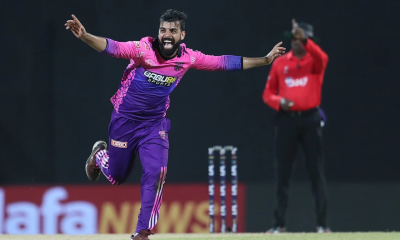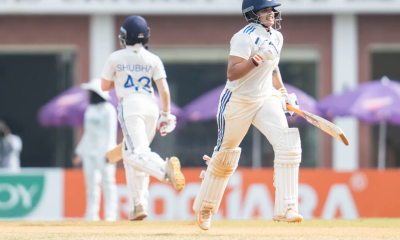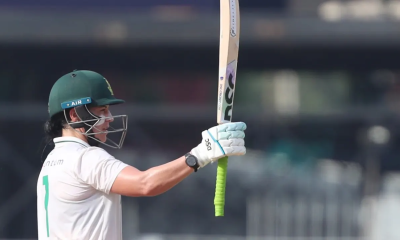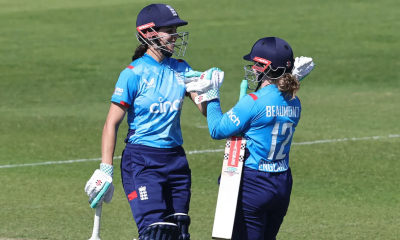Features
Clive Inman recalls cricketing life in 2020 interview

Clive Clay Inman (born January 29, 1936 in Colombo died on December 7, 2022 in England). He was a former Ceylon cricketer, represented NCC in domestic Club Cricket and later played English County Cricket representing Leicestershire and Derbyshire. He captained his alma mater, St Peter’s College, Colombo 04 in 1954 and 1955 and won the Battle of the Saints Big match against St. Joseph’s College Colombo in 1955.
He comes from a family of cricketers. His father, Harry Inman, played for Ceylon teams as an allrounder. Clive had four brothers, all cricketers, of whom Roger played and captained S. Thomas’ College in 1952 (Clive played against him for St. Peter’s). Clive was a prolific left-hand batsman and also a right arm off break bowler who excelled during his school career, and later on, built a name for himself as an outstanding batsman for Ceylon and English County Leicestershire during the 60’s.
Call it a scoop, call it an exclusive interview, call it whatever you wish, but to this writer it was a scoop, a rare opportunity grabbed with both hands by Sujith Silva (Editor in Chief of Quadrangle), Brian Lawrence (also of Quadrangle) and myself (Algi Wijewickrema). The personality that Sujith, Brian and I had the extremely rare privilege of having this telephone interview was Clive Clay Inman, a much talked of cricketer in the 1950s and 60s.
Now in his 84th year, Clive — who represented Leicestershire from 1963 to 1971 as one of their top middle order batsmen– continues to live in England and we were able to contact him thanks to the modern day communication tools.
Born in 1936 to Harry and Edith Inman, Clive lived with his parents and siblings in Wellawatte. At the time he was to be admitted to school (possibly in 1941, he could not recall the exact year), he was expected to enter S. Thomas’ College (STC), Mt. Lavinia like his brothers, Earnest, Trevor and Roger. But fate decreed otherwise.
Said Clive, “The entrance exam at S. Thomas’ was a lengthy, two part ordeal commencing in the morning and running into the second session after a break for lunch; but by lunch time I had decided not to continue.” He had decided to join St. Peter’s despite his father’s desire to have him enrolled at STC. When his father had found out from the Thomian headmaster that he had not stayed for the entire exam, he had come home and asked Clive why. And Clive had told him that he wanted to join St. Peter’s College. “Father and mother then had a chat and father gave his consent and I joined St. Peter’s.”
Let me quote Clive on what he thought of his decision to join St. Peter’s, “I enjoyed being at St. Peter’s from the time I was admitted. The Rector then was Rev. Fr. Basil Wiratunga, who was a great man. I had no regrets whatsoever as I was looked after well”.
Clive’s cricket at St. Peter’s had begun at the age of 15 in 1950 as a left-handed batsman. He said: “I played as a batsman though I may have bowled a little, but I always preferred batting to bowling.” He continued “We had Herbert Wittachchi as our team coach, but my personal coach was Cyril Ekanayake. He (Cyril) had not been a cricketer of any standing but was an excellent coach and in my opinion no one could match him. He could not bowl but shied the ball from halfway down the wicket, getting me to hit it, 10 minutes of the forward defence and 10 minutes of backfoot defence and so on”.
With all three of his brothers playing cricket for STC, interestingly his brother Roger – the only one to captain STC – had captained STC in 1952 the year Clive played for St. Peter’s under H I K Fernando. Although the brothers were Thomian cricketers and he the only Peterite in the family, there had not been any arguments at home. Clive recalled “When I first played for St. Peter’s, my mother told Roger that if he was bowling when I came in to bat, he should allow me to get off the mark and Roger protested saying he couldn’t do that. But mother insisted saying he’d have her to answer to, if that did not happen. And that was the end of discussion”.
Recounted Clive “My mother was my greatest fan and never missed a match I played in. My father also attended matches that I played in but not all and was late for some. Once he came late for a match when I was batting and not long after he arrived I got out. At home that night my mother insisted that he either arrives for the match before the start or not show himself till I had got out; and that is exactly how it was with my father and his attendance at Peterite matches”.
Although his record score of 204 retired hurt in the Big Match (Joe-Pete) was when he first captained in 1954, he said “My most memorable match was the Josephian-Peterite encounter in 1955 which we won at the Colombo Oval that was packed with spectators on both days.” In that match the Joes had batted first and had been bowled out for a paltry 117 and the Petetites had rattled up 224 in the first inning. In their second inning the Joes had done better scoring 150 leaving the Petes 44 to win, which they had scored for the loss of 2 wickets (46/2).
This, no doubt, was memorable not only for Clive, but for all Peterites as it was a win earned after seven years but more importantly it was only their third win after the two consecutive victories under Dion Walles in 1946 and 1947.
Comparing the two Big Matches of 1954 and 1955 under his captaincy, Clive’s attitude was “Whether I scored a century or zero, what was important for me was whether we won or not.”
He recalled how he was detained once for talking in class and when in the detention class after school who walks in but Cyril Ekanayake. Upon learning from Clive why he was talking in class – which had been a discussion with Ken Duckworth about the next match – he had been allowed to go home.
Asked to recall some of the teammates who have stayed in his memory he recalled Luckshman Serasinghe, Kenneth and Russel Duckworth, Brian Seneviratne (wicket keeper), Brian and Maurice de Silva and Ranjith Jayasinghe. He singled out H I K Fernando as a top-notch wicket keeper and a great batsman. The only non-Peterite cricketer he could recall was ACM Lafir of St. Anthony’s College, Katugastota.
Apart from the two coaches, Herbert Wittachchi and Cyril Ekanayake, he remembered Rev. Fr. Rodrigo (he couldn’t recall the first name), who had been the Prefect of Games then and the groundsman Nomis. About Nomis he even recalled: “Nomis would say “Wish I could swim better” because I used to frequently hit the ball into the canal and he had to retrieve them.”
Speaking about the Rector, Fr. Basil Wiratunga, he reminisced “In 1955 before the Big Match Fr. Rector asked me what I wanted if St. Peter’s is to win. I told him we needed bats, gloves and pads for the players. I also requested that the cricketers should be excused from afternoon classes. He said “done”.
“Even Masters at College used to tell me that I had more influence over the Rector than anyone else. He backed me all the way and at no other school could this have been done. The Big Match win that year was as much a celebration for Fr. Rector as it was for me since it was the last Big Match for both of us”.
When Clive ended his cricketing career at St. Peter’s spanning five years (1951-1955) he had scored one double century, five centuries and 17 fifties and as captain in 1954 and 1955, earned four wins against one loss.
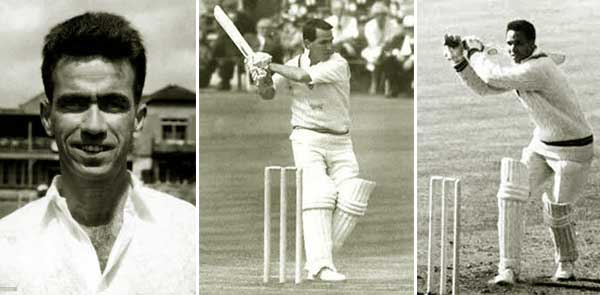
After leaving College, Clive had joined Colts Cricket Club as his uncle was there, but later in 1956 had moved to NCC for three reasons (1) he admired the then NCC Captain, (2) H I K Fernando his former Peterite captain playing for NCC at the time and (3) his friend Stanley Jayasinghe being in the NCC team.
Making his first-class debut in 1956, representing Ceylon against India at the Colombo Oval he had not been able to make an impression, but said that throughout his career he was happy batting and could not recall bowling at any match. However, records show that he has bowled in this match and a few other matches.
Clive represented Ceylon in the Gopalan Trophy matches against Madras, which was the only regular first class international cricket Ceylon had before gaining test status. Though Clive’s appearances for Ceylon were not regular he did represent Ceylon in 1956-57 and 1958-59 in the Gopalan Trophy and against the touring MCC in 1961-62. He toured Pakistan in 1966-67.
Speaking of being selected to play for Ceylon and not playing Clive reminisced “On one occasion Stanley Jayasinghe had written an article to a newspaper critical of the Board of Control for Cricket in Ceylon or against the South Africans and apartheid and had been omitted from the team to represent Ceylon. I was in England, but had been selected and received my contract.
“On going through the contract I found that Sanley’s name was not there. I called uncle Sara and asked him about it and said I would not come. He said “don’t be a fool” but I stood firm and told him Stanley is the best batsman in Ceylon and should be in the team. So, I refused to play for Ceylon on that occasion.”
Once he had moved to England and joined his friend from Ceylon, Stanley Jayasinghe, in his first appearance for Leicestershire in 1961, Clive had played against the touring Australian side contributing 30 and 45 not out. However, he had represented Leicestershire in the County Championships for the first time only in 1963 after completing the mandatory two-year residential qualification period. His maiden first class century for the county had been in his first county championship year in 1963 against the University of Cambridge.
Asked to comment about his Guinness Record of 50 runs in eight minutes for Leicestershire, Clive said the record lost its glow when in the next match he got a 50 and helped Leicester to win. But recalling that match, he said he regretted he was not able to hit a six to land in the river beyond the boundary and the fact that Stanley Jayasinghe (another Sri Lankan cricketer of repute), also playing for Leicestershire, being run out for 99 in that match.
Of playing against famous international teams Clive said that he had played against West Indies, Australia, India and Pakistan when they played against his County, Leicestershire. Continuing to speak of cricket against international teams and the bowling he had faced, Clive said “Wes Hall, Charlie Griffith of the West Indies and Dennis Lillee of Australia are some of the overseas cricketers I have batted against.
“Also while playing county cricket, I have played against some of the great English bowlers such as Fred Trueman, Brain Statham and Frank Tyson. The greatest all rounder for me is Sir Garfield Sobers”. Asked to comment on how he played such great bowlers of his time he said “I just played each ball on its merits”.
I couldn’t resist asking him if he would be able to visit St. Peter’s for its centenary celebrations in 2022, but with regrets in his voice he said “No, my traveling days finished 10–12 years ago when I broke both my ankles. I can walk now but with great difficulty and not long distances. But give my best regards to all at St. Peter’s College”.
Of his family, his wife Josephine has passed away 14 years ago and apart from a son who died when he was small, he had lost another son a few years ago and the only surviving son, Andrew, lives in Australia.Asked to comment about good Sri Lankan cricketers in Sri Lanka (current and recent), Clive picked Kumar Sangakkara and Mahela Jayawardena as exceptional cricketers.
Coming towards the end of our telephone interview Clive said “I refused to be involved with English cricket and always wanted to play for Ceylon (now Sri Lanka), which I still call home and moreover, I ask what could I have done if I was selected to play for England and England was playing against Ceylon”.
Asked for any advice for young cricketers his advice was “You can’t play without practice. So, practice, practice and practice for that is how you can improve”.
On that note of good advice from a brilliant cricketer of yesteryear, we concluded “The Scoop”.
Our sincere appreciation to Old Peterite Mr. Brian Ratnayake (England) for his efforts to get us in touch with Clive Inman and Mr. Andrew Inman (Australia) son of Clive Inman for sharing valuable images of his father. ……. Image credits; courtesy of Leicestershire County Cricket Club, Stanley Jayasinghe and Andrew Inman. (www.quadrangle.lk)
Features
SL urged to use GSP+ to the fullest to promote export development
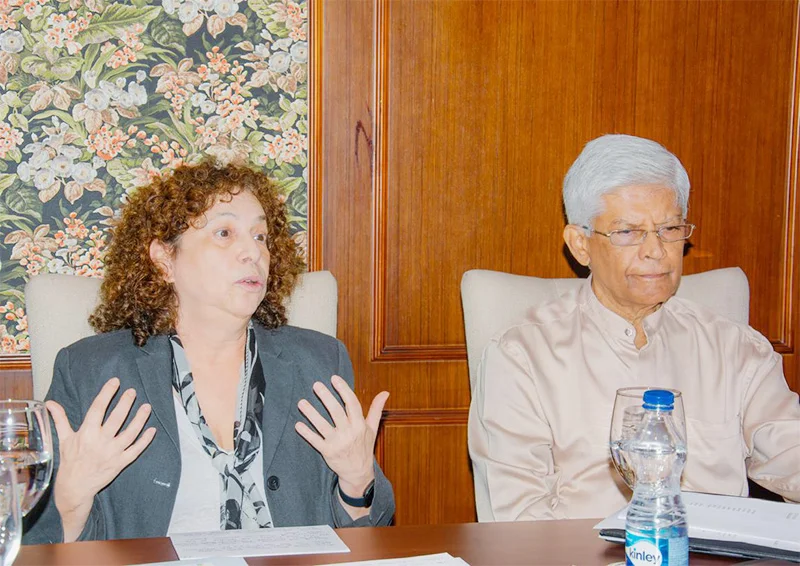
 Sri Lanka needs to take full stock of its current economic situation and use to the maximum the potential in its GSP+ facility for export sector growth. In the process, it should ensure that it cooperates fully with the European Union. The urgency of undertaking these responsibilities is underscored by the issues growing out of the recent US decision to sweepingly hike tariffs on its imports, though differentially.
Sri Lanka needs to take full stock of its current economic situation and use to the maximum the potential in its GSP+ facility for export sector growth. In the process, it should ensure that it cooperates fully with the European Union. The urgency of undertaking these responsibilities is underscored by the issues growing out of the recent US decision to sweepingly hike tariffs on its imports, though differentially.
These were principal ‘takes’ for participants in the Pathfinder Foundation’s Ambassadors’ Roundtable forum held on April 8th at the Colombo Club of the Taj Samudra. The main presenter at the event was Ms. Carmen Moreno Raymundo, Ambassador of the European Union to Sri Lanka and the Maldives. The forum was chaired by Ambassador Bernard Goonetilleke, Chairman, Pathfinder Foundation. The event brought together a cross-section of the local public, including the media.
Ms. Moreno drew attention to the fact Sri Lanka is at present severely under utilizing its GSP+ facility, which is the main means for Sri Lanka to enter the very vast EU market of 450 million people. In fact the EU has been Sri Lanka’s biggest trading partner. In 2023, for instance, total trade between the partners stood at Euros 3.84 billion. There is no greater market but the EU region for Sri Lanka.
‘However, only Sri Lanka’s apparel sector has seen considerable growth over the years. It is the only export sector in Sri Lanka which could be said to be fully developed. However, wider ranging export growth is possible provided Sri Lanka exploits to the fullest the opportunities presented by GSP+.’
Moreno added, among other things: ‘Sri Lanka is one among only eight countries that have been granted the EU’s GSP+ facility. The wide-ranging export possibilities opened by the facility are waiting to be utilized. In the process, the country needs to participate in world trade in a dynamic way. It cannot opt for a closed economy. As long as economic vibrancy remains unachieved, Sri Lanka cannot enter into world trading arrangements from a strong position. Among other things, Sri Lanka must access the tools that will enable it to spot and make full use of export opportunities.
‘Sri Lanka must facilitate the private sector in a major way and make it possible for foreign investors to enter the local economy with no hassle and compete for local business opportunities unfettered. At present, Lanka lacks the relevant legal framework to make all this happen satisfactorily.
‘Sri Lanka cannot opt for what could be seen as opaque arrangements with bilateral economic partners. Transparency must be made to prevail in its dealings with investors and other relevant quarters. It’s the public good that must be ensured. The EU would like to see the local economy further opening up for foreign investment.
‘However, it is important that Sri Lanka cooperates with the EU in the latter’s efforts to bring about beneficial outcomes for Sri Lankans. Cooperation could be ensured by Sri Lanka fully abiding by the EU conditions that are attendant on the granting of GSP+. There are, for example, a number of commitments and international conventions that Sri Lanka signed up to and had promised to implement on its receipt of GSP+ which have hitherto not been complied with. Some of these relate to human rights and labour regulations.
‘Successive governments have pledged to implement these conventions but thus far nothing has happened by way of compliance. GSP+ must be seen as an opportunity and not a threat and by complying with EU conditions the best fruits could be reaped from GSP+. It is relevant to remember that GSP+ was granted to Sri Lanka in 2005. It was suspended five years later and restored in 2017.
‘The importance of compliance with EU conditions is greatly enhanced at present in view of the fact that Sri Lanka is currently being monitored by the EU with regard to compliance ahead of extending GSP+ next year. A report on Sri Lanka is due next year wherein the country’s performance with regard to cooperating with the EU would be assessed. The continuation of the facility depends on the degree of cooperation.
‘A few statistics would bear out the importance of Sri Lanka’s partnership with the EU. For example, under the facility Sri Lanka benefits from duty free access in over 66% of EU tariff lines. The highest number of tourist arrivals in Sri Lanka in 2023 was from the EU’s 27 member states. Likewise, the EU’s 27 member states rank second in the origin of inflows of foreign exchange to Sri Lanka; with Italy, France and Germany figuring as the main countries of origin. Eighty five percent of Sri Lanka’s exports to the EU market benefits from GSP+. Thus, the stakes for the country are high.’
Meanwhile, President, In-house Counsel & Legal Advisor, The European Chamber of Commerce of Sri Lanka, John Wilson said: ‘GSP+ should be seen as not only an opportunity but also as a necessity by Sri Lanka in the current international economic climate. ‘Implementation of local laws is what is needed. Considering the pressures growing out of the US imposed new tariff regime, a good dialogue with the EU is needed.
‘Sri Lanka’s level of business readiness must be upped. Among the imperatives are: An electronic procurement process, Customs reforms, a ‘National Single Window’, stepped-up access to land by investors, for example, a clear policy framework on PPPs and reform of the work permits system.’
It ought to be plain to see from the foregoing that Sri Lanka cannot afford to lose the GSP+ facility if it is stepped-up economic growth that is aimed at. It would be in Sri Lanka’s best interests to remain linked with the EU, considering the aggravated material hardships that could come in the wake of the imposition of the US’ new tariff regime. Sri Lanka would need to remain in a dialogue process with the EU, voice its reservations on matters growing out of GSP+, if any, iron out differences and ensure that its national interest is secured.
Features
SENSITIVE AND PASSIONATE…
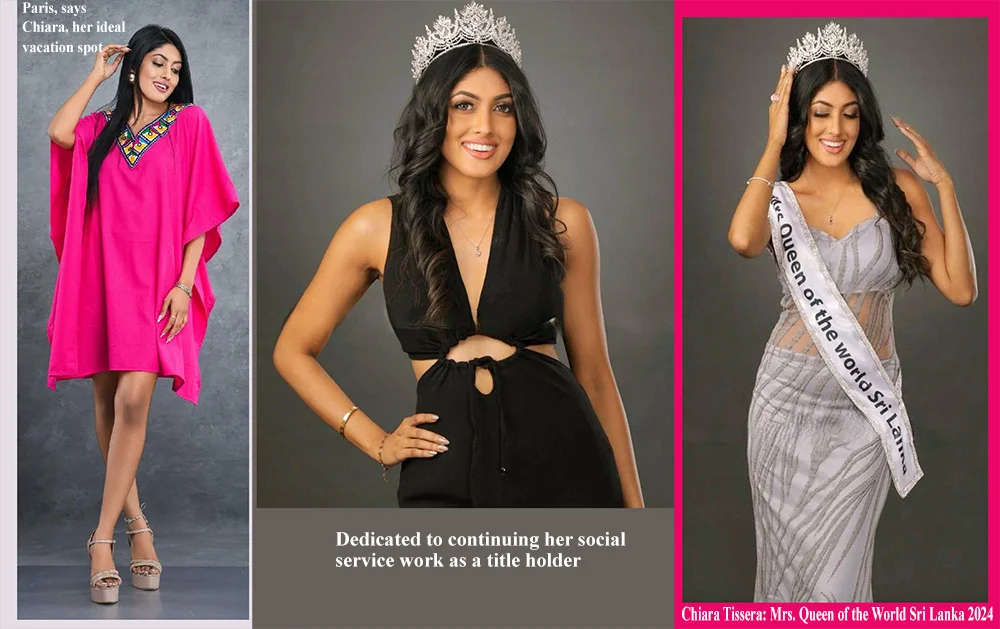
Chit-Chat
Chiara Tissera
Mrs. Queen of the World Sri Lanka 2024, Chiara Tissera, leaves for the finals, in the USA, next month
I had a very interesting chat with her and this is how it all went:
1. How would you describe yourself?
I am a sensitive and passionate individual who deeply cares about the things that matter most to me. I approach life with a heart full of enthusiasm and a desire to make meaningful connections.
2. If you could change one thing about yourself, what would it be?
Actually, I wouldn’t change a thing about myself because the person I am today, both inside and out, is the result of everything I’ve experienced. Every part of me has shaped who I am, so I embrace both my strengths and imperfections as they make me uniquely me.
3. If you could change one thing about your family, what would it be?
If there’s one thing I could change about my family, it would be having my father back with us. Losing him six years ago left a void that can never be filled, but his memory continues to guide and inspire us every day.
4. School?
I went to St. Jude’s College, Kurana, and I’m really proud to say that the lessons I gained during my time there have shaped who I am today. My school and teachers instilled in me values of hard work, perseverance and the importance of community, and I carry those lessons with me every day. I was a senior prefect and was selected the Deputy Head Prefect of our college during my tenure.
5. Happiest moment?
The happiest moment of my life so far has been winning the Mrs. Sri Lanka 2024 for Queen of the World. It was a dream come true and a truly unforgettable experience, one that fills me with pride and gratitude every time I reflect on it.
6. What is your idea of perfect happiness?
Happiness is a deeply personal and multifaceted feeling that often comes from a sense of contentment, fulfillment and well-being. For me, perfect happiness is in moments of joy, peace and accomplishments … and also being surrounded by my loved ones.
7. Are you religious?
Yes, I’m a very religious person. And I’m a firm believer in God. My faith guides me through life, providing strength, dedication and a sense of peace in every situation. I live by the quote, ‘Do your best, and God will do the rest.’
8. Are you superstitious?
I’m not superstitious. I believe in making my own decisions and relying on logic and faith rather than following superstitions.
9. Your ideal guy?
My ideal guy is my husband. He is compassionate, understanding and is always there to support me, no matter what. He’s my rock and my best friend – truly everything I could ever want in a partner.
10. Which living person do you most admire?
The living person I admire the most is definitely my mummy. Her strength, love and unwavering support has shaped me into who I am today. She is my role model and she inspires me every day with her wisdom and kindness.
11. Your most treasured possession?
My most treasured possession is my family. They are the heart of my life, providing me with love, support and strength. Their presence is my greatest blessing.
12. If you were marooned on a desert island, who would you like as your companion?
I would like to have my spouse as my companion. Together, we could make the best of the situation, supporting each other, sharing moments of laughter and finding creative ways to survive and thrive.
13. Your most embarrassing moment?
There’s quite a few, for sure, but nothing is really coming to mind right now.
14. Done anything daring?
Yes, stepping out of my comfort zone and taking part in a pageant. I had no experience and was nervous about putting myself out there, but I decided to challenge myself and go for it. It pushed me to grow in so many ways—learning to embrace confidence, handle pressure, and appreciate my own uniqueness. The experience not only boosted my self-esteem but also taught me the value of taking risks and embracing new opportunities, even when they feel intimidating.”
15. Your ideal vacation?
It would be to Paris. The city has such a magical vibe and, of course, exploring the magical Eiffel Tower is in my bucket list. Especially the city being a mix of history culture and modern life in a way that feels timeless, I find it to be the ideal vacation spot for me.
16. What kind of music are you into?
I love romantic songs. I’m drawn to its emotional depth and the way they express love, longing a connection. Whether it’s a slow ballad, a classic love song or a more modern romantic tune these songs speak to my heart.
17. Favourite radio station?
I don’t have a specific radio station that I like, but I tend to enjoy a variety of stations, depending on my mood. Sometimes I’ll tune into one for a mix of popular hits, other times I might go for something more relaxing, or a station with a certain vibe. So I just like to keep it flexible and switch it up.
18. Favourite TV station?
I hardly find the time to sit down and watch TV. But, whenever I do find a little spare time, I tend to do some spontaneous binge – watching, catching whatever interesting show is on at that moment.
19 What would you like to be born as in your next life?
Mmmm, I’ve actually not thought about it, but I’d love to be born as someone who gets to explore the world freely – perhaps a bird soaring across continents.
20. Any major plans for the future?
Let’s say preparing and participating in the international pageant happening in the USA this May. It’s an exciting opportunity to represent myself and my country on a global stage. Alongside this, I am dedicated to continuing my social service work as a title holder, striving to make a meaningful difference in the lives of others through my platform.
Features
Fresher looking skin …

 The formation of wrinkles and fine lines is part of our ageing process. However, if these wrinkles negatively impact appearance, making one look older than they actually are, then trying out some homemade remedies, I’ve listed for you, this week, may help in giving your skin a fresher look.
The formation of wrinkles and fine lines is part of our ageing process. However, if these wrinkles negatively impact appearance, making one look older than they actually are, then trying out some homemade remedies, I’ve listed for you, this week, may help in giving your skin a fresher look.
* Banana:
Bananas are considered to be our skin’s best friend. They contain natural oils and vitamins that work very perfectly to boost our skin health. Skincare experts recommend applying the banana paste to the skin.
Take a ripe banana and mash a quarter of it until it becomes a smooth paste. Apply a thin layer of the banana paste on your skin and allow it to sit for 15 to 20 minutes before washing it off with warm water.
* Olive Oil:
Olive oil works as a great skin protector and many types of research suggest that even consuming olive oil may protect the skin from developing more wrinkles. Olive oil contains compounds that can increase the skin’s collagen levels. Yes, olive oil can be used as a dressing on your salads, or other food, if you want to consume it, otherwise, you can apply a thin layer of olive oil on your face, neck and hands and let it stay overnight.
* Ginger:
Ginger serves to be a brilliant anti-wrinkle remedy because of the high content of antioxidants in it. Ginger helps in breaking down elastin, which is one of the main reasons for wrinkles. You can have ginger tea or grate ginger and have it with honey, on a regular basis.
* Aloe Vera:
The malic acid present in Aloe Vera helps in improving your skin’s elasticity, which helps in reducing your wrinkles. Apply the gel once you extract it from the plant, and leave it on for 15-20 minutes. You can wash it off with warm water.
* Lemons:
Lemons contain citric acid, which is a strong exfoliant that can help you get rid of your dead skin cells and wrinkles. Also, as an astringent and a cleansing agent, it helps to fade your wrinkles and fine lines. You can gently rub a lemon slice in your wrinkled skin and leave it on for 10-15 minutes. Rinse afterwards and repeat this process two to three times a day.
* Coconut Oil:
Coconut oil contains essential fatty acid that moisturises the skin and helps to retain its elasticity. You can directly apply the coconut oil, and leave it overnight, after gently massaging it, for the best results.
-

 Business3 days ago
Business3 days agoColombo Coffee wins coveted management awards
-

 Business5 days ago
Business5 days agoDaraz Sri Lanka ushers in the New Year with 4.4 Avurudu Wasi Pro Max – Sri Lanka’s biggest online Avurudu sale
-

 Features4 days ago
Features4 days agoStarlink in the Global South
-

 Business6 days ago
Business6 days agoStrengthening SDG integration into provincial planning and development process
-

 Business5 days ago
Business5 days agoNew SL Sovereign Bonds win foreign investor confidence
-

 Features1 day ago
Features1 day agoSri Lanka’s Foreign Policy amid Geopolitical Transformations: 1990-2024 – Part III
-

 Features4 days ago
Features4 days agoModi’s Sri Lanka Sojourn
-

 Midweek Review1 day ago
Midweek Review1 day agoInequality is killing the Middle Class




